I have regularly used this lens with the Nikon Z50 camera for telephoto work and have been very happy with the image results, I have found it to be an excellent performing lens. The lens mount is plastic rather than metal but this should not be a problem as todays plastics are very robust. My wife has also used this Z50 for some time and is very happy with the images from the lens and also the Z50 camera.
This lens from Nikon was the first of the Mirrorless DX lenses. It is retractable so that it is quite small for a 50-250mm lens when retracted and approximately increases by one quarter in size, when it is extended for operation. The lens is a very compact lens for a 250mm zoom telephoto lens.
The 50 to 250mm lens (35mm equivalent focal length of 75 to 375mm with DX cameras),
has a maximum aperture of f/4.5 to 6.3 and a minimum aperture of f/16 with an angle of view of 31° 30′ to 6° 30′. The minimum focus distance is 1.64′ (50 cm) with a maximum magnification of 0.23 times. The optical design of the lens has 16 elements in 12 groups with 7 rounded diaphragm blades to give a nice bokeh.
The lens is an autofocus lens and has inbuilt image Stabilization. The front filter size is 62 mm and the dimensions of the lens are 2.91″ (74mm) in diameter and 4.33″ (110 mm) in length with a weight of 14.29 oz (405 grams).
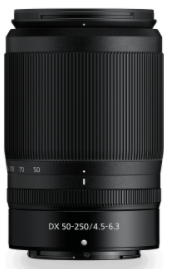
This lens with one of the small DX Nikon cameras such as the Z50 forms an extremely small outfit but with a very good to excellent output as far as image quality is concerned.
This lens turns out to be quite a long lens when used with a DX camera, 375mm.
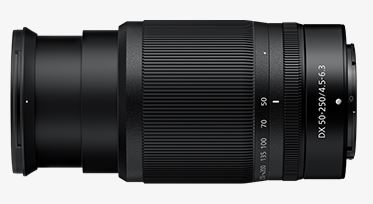
The above image shows the lens in its extended position. This lens is retracted or extended by turning the zoom ring.
I am quite amazed at the sharpness of this 50-250mm zoom lens. As this lens is designed for the Nikon DX Mirrorless range of cameras it really has an equivalent focal length range of 75-375mm. When compared to the full frame range of lenses this is a very small lens for its focal length. One of the short comings of a compact lens such as this is that the aperture is rather limiting due to its limited f/6.3 aperture opening. My philosophy on many occasions is to use relatively large apertures, to limit the depth of field and to highlight the subject.

Sample Images
I have included some water lily images below which have been captured with the DX 50-250mm f4.5-6.3 VR Lens on the Nikon Z50 DX camera.
The first image below of the water lily with the bee on it has been captured with the following settings;
Camera Info,
- Device: Nikon Z 50,
- Focal Length: 250mm
Exposure,
- Aperture: f/6.3,
- Shutter Speed: 1/800s,
- Exposure Mode: Aperture Priority,
- Exposure Comp.: 0EV,
- Metering: Matrix,
- ISO Sensitivity: 100
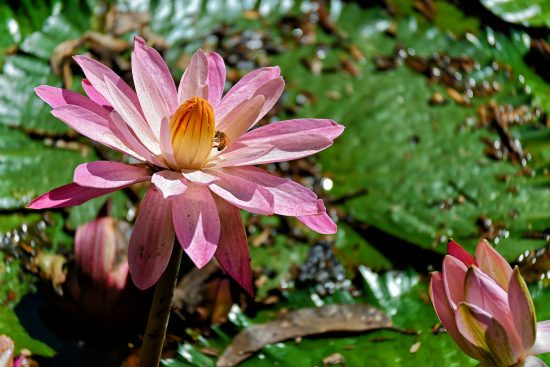 Water Lily with Bee
Water Lily with Bee
I am fairly amazed at the sharpness of the next image which is a 100% crop of a section of the above image of the bee. There does appear to be plenty of sharpness and detail in the 100% crop of the bee here.

The second image below if of a water lily again, but this time with a frog sitting on the water lily.
Camera Info,
- Device: Nikon Z 50,
- Lens: NIKKOR Z DX 50-250mm f/4.5-6.3 VR,
- Focal Length: 250mm,
- Focus Mode: AF-A,
- AF-Area Mode: Auto;
- VR: ON,
- AF Fine Tune: OFF
Exposure
- Aperture: f/6.3,
- Shutter Speed: 1/640s,
- Exposure Mode: Aperture Priority,
- Exposure Comp.: 0EV,
- Metering: Matrix,
- ISO Sensitivity: Auto (ISO 100).
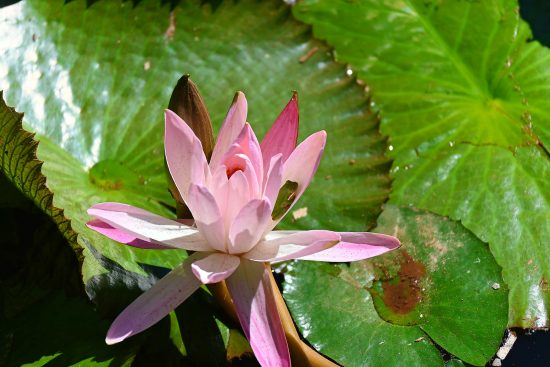
The second image of the frog below is again a 100% crop from the image just above and again I am somewhat amazed at how goot the sharpness and detail is with this 50-250mm lens and Z50 camera combination.
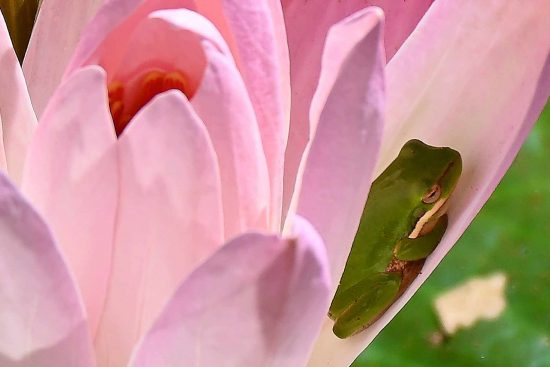
Lens Specification
The specification of the DX 50-250mm f4.5-6.3 VR Lens is as follows:
- Nikon Z mount.
- DX Format.
- Focal length, 50 – 250mm.
- Maximum aperture, f/4.5 to f/6.3.
- Minimum aperture, f/22 to f/32.
- Lens construction, 16 elements in 12 groups (including 1 ED element).
- Angle of view, DX image area, 31° 30′ to 6° 30′.
- Focal length scale is graduated in millimeters at 50, 70, 100, 135, 200 and 250mm.
- Internal focusing system.
- Minimum focus distance, measured from the focal plane,
- 50 mm zoom position: 0.5 m (1.64 ft),
- 70 mm zoom position: 0.52 m (1.71 ft),
- 100 mm zoom position: 0.58 m (1.91 ft),
- 135 mm zoom position: 0.65 m (2.14 ft).
- 200 mm zoom position: 0.83 m (2.73 ft),
- 250 mm zoom position: 1.0 m (3.29 ft).
- Maximum reproduction ratio, 0.23 x.
- Vibration Reduction, VR, lens shift using voice coil motors (VCMs).
- Number of diaphragm blades, 7 with a rounded diaphragm opening.
- Filter attachment size, 62 mm (P = 0.75 mm).
- Dimensions, 74 mm (3 inches) diameter x 110mm (4.4 inches) (distance from camera lens mount flange when the lens is retracted).
- Weight, 405 grams (14.3 oz.).
- Autofocus.
- Internal focusing.
- Switchable Auto, Manual focusing.
Supplied accessories
- LC-62B, 62 mm Snap-on Front Lens Cap.
- LF-N1, Rear Lens Cap.
If you need any camera gear similar to what I use, I recommend you try B&H on the link below for your purchases.
All of the following images in this Gallery have been captured with the 50-250mm lens and the Z50 camera. All of the images are straight out of the camera with no processing.










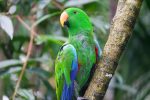

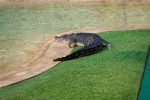
1 comment
Comments are closed.